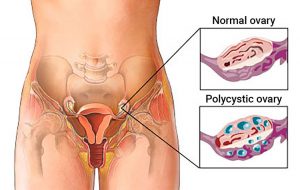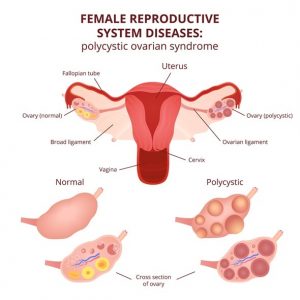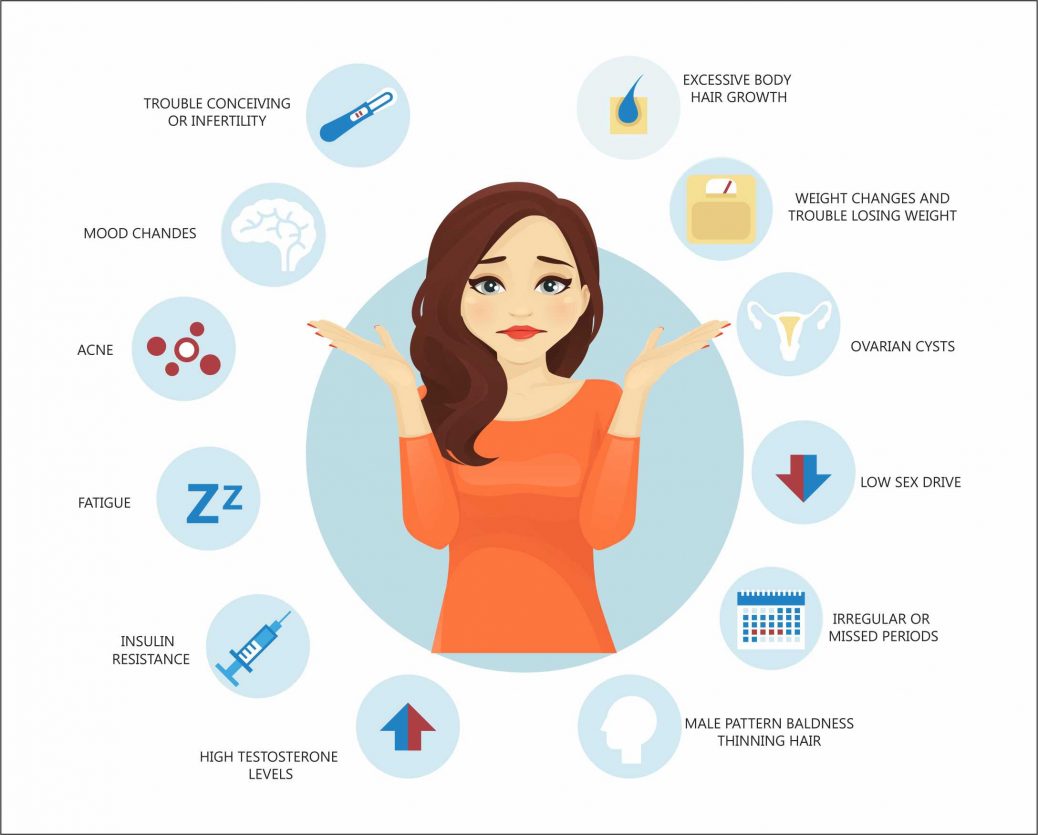Polycystic Ovarian Syndrome : Definition, Causes, Symptoms, Treatment And MCQs for NEET, GPAT, CSIR NET JRF
” It is an syndrome in which woman’s hormones are out of balance and leads to oligomenorrhea, anovulation, infertility, hirsutism and obesity in young women.”
1.] It is also called Polycystic Ovarian Disease [PCOD] or Stein – Leventhal syndrome.

The above image is taken for education purpose only from womenshealth.com
CAUSES :-
In PCOD principle biochemical abnormalities in most of the patients are excessive production of androgen, and low level of pituitary follicle stimulating hormone [FSH]. Also, the initiative stages of PCOD are not so much clear, but theoretically increased secretion of LH stimulates the theca lutein cells of the follicle, with excessive production of androgen, which is converted to estone. Pathogenesis of PCOS is the unbalanced release of FSH and LH by the pituitary.

The above image is taken for education purpose only from news – medical.net
SYMPTOMS :-
Some of the common symptoms of PCOD are as follows :
- Due to hormonal problems / imbalance, it leads to irregular periods which leads to heavy bleeding or no periods
- Many of the women, suffering from PCOS have fertility problems
- Weight gain and acne all over the face
- Excessive hair growth on face, belly, chest and neck
- Thinning of hair on the scalp
- Depression
- Hirsutism ( Abnormal hair growth on women face and body)
- Oligomenorrhea (absence of menses)
- Anovulation (absence or lack of ovulation)

The above image is taken for education purpose only from conquerpcos.org
TREATMENT :-
Following are the medications given to the patients suffering from PCOD :
- Tranexamic Acid (Trapic MF) is used for the reduction or prevention of excessive menstrual bleeding.
- Metformin (Glucophage, Glucophage XR, Fortamet and Glumetza) is used to increase the body’s sensitivity to insulin.
- For balanced maturation and release of egg, clomiphene citrate is given.
- Vaniqa (eflornithine hydrochloride) cream is given for decrease in excessive hair growth.
MULTIPLE CHOICE QUESTIONS :-
1.] Polycystic ovarian syndrome is the prominent cause of ?
a. Obesity
b. Dyslipidemia
c. Insulin resistance
d. Infertility
2.] Clinical manifestations of PCOS include the following ?
a. Facial hair
b. Acne
c. Amenorrhea or irregular menses
d. All of the above
3.] All are true about PCOD except ?
a. Persistently elevated LH
b. Increased LH/FSH ratio
c. Increased DHEAS
d. Increased prolactin
4.] Age at which PCOS is commonly diagnosed ?
a. 18 – 44 years
b. Less than 13 yrs.
c. More than 50 yrs.
d. None of the above
5.] A positive family history and excess insulin secretion by the pancreas are thought to play a role in the etiology of PCOD ?
a. True
b. False
6.] Which of the findings listed below that occur in PCOS are attributable to hyperandogenism ?
a. Weight loss in spite of increased appetite
b. Excess body and facial hairs
c. Tall stature
d. All of the above
7.] PCOS was first discovered by ?
a. Louis Pasteur
b. Stein and Levinthal
c. Pavlov
d. None of the above
8.] The major reason for women with PCOS to suffer from infertlity is ?
a. Obesity
b. Abnormal menstrual cycles
c. Excess insulin level
d. None of the above
9.] Women suffering from PCOS are at increased risk of developing ?
a. Diabetes
b. Dyslipidemias
c. Endometrial cancer
d. All of the above
10.] Diagnostic imaging test done in suspected PCOS include ?
a. Pelvic ultrasound
b. Transvaginal ultrasound
c. MRI
d. All of the above
SOLUTIONS :-
1.] (d) Infertility
2.] (d)
3.] (d) Increased prolactin
4.] (a) 18 – 44 yrs.
5.] (a)
6.] (b) Excess body and facial hair
7.] (b) Stein and Levinthal
8.] (b) Abnormal menstrual cycle
9.] (d)
10.] (d)
List of Successful GPATINDIAN CANDIDATES
REFERENCES :-
1.] Textbook Of Pathology By Harsh Mohan; 7th edition; Page no. 730.
2.] Robbin’s Basic Pathology; 5th edition; Page no. 1064 – 1065.